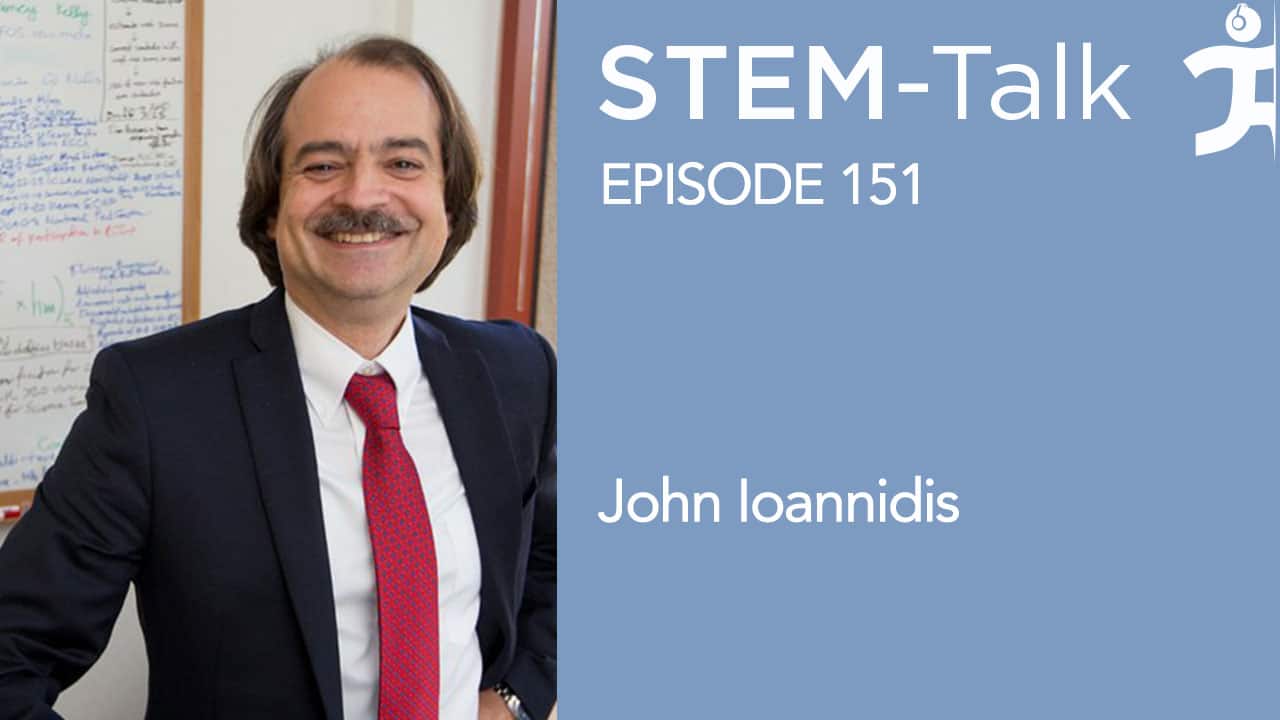STEM-Talk
Episode 151: John Ioannidis talks about the bungled response to COVID-19
// Apr 19, 2023

Back in early days of the COVID-19 pandemic, Dr. John Ioannidis wrote an article in March of 2020 questioning government statistics about the fatality rate associated with COVID-19. The backlash was swift and brutal and John’s reputation as one of the most influential scientists in the world took a beating.
Today, John makes his second appearance on STEM-Talk to discuss his extensive research into the COVID-19 pandemic as well as the public shaming he received in 2020 for questioning the World Health Organization’s prediction of a 3.4 percent fatality rate associated with COVID-19.
John also talks about his most recent peer-reviewed paper that looked at the age-stratified infection fatality rate of COVID-19 in the non-elderly population. The study found that the pre-vaccination fatality rate for those infected may have been as low as 0.03 percent for people under 60 years old, and 0.07 percent for people under 70, far below the World Health Organization’s prediction of a 3.4 percent fatality rate.
In today’s episode, John walks us through this paper, which was published in January, as well as what he describes as the U.S. government’s bungled response to COVID-19. He also discusses the importance of collecting reliable data in the future to guide disease modelers and governments before they make decisions of monumental significance like lockdowns. He goes on to share how he underestimated the power that politics and the media, or powers outside of science, can have on science.
Over the past two decades, John’s research has earned him a global reputation as a consummate physician and researcher, which contributed to The Atlantic describing John in 2010 as one of the most influential scientists alive. He is a professor of Medicine, Epidemiology and Population Health as well as a statistician and professor of biomedical data science at Stanford University.
Back in 2018 when we interviewed John on episode 77 of STEM-Talk, we talked to him about his 2005 paper questioning the reliability of most medical research. The paper, titled, “Why Most Published Research Findings Are False,” found that much of the medical science reported in peer-reviewed journals is flawed and cannot be replicated. The paper is the most citied article in the history of the journal PLoS Medicine and has been viewed more than 3 million times.
Show notes:
[00:03:16] Dawn opens the interview welcoming John back to STEM-Talk. his last appearance being in 2018. Dawn explains that when John last appeared on STEM-Talk in 2018, he was described by Atlantic Magazine as “one of the most influential scientists alive.” But in the intervening years, John became public enemy number one in 2020 after a paper he published questioning government statistics about COVID 19’s fatality rate. Dawn asks John if it’s fair to say that he has been on a rather rocky ride for the past few years. [00:03:54] Dawn explains that John was trained at Harvard and Tufts universities in internal medicine and infectious disease, and asks John what led him to study infectious disease. [00:04:54] Ken asks John about his initial thoughts in 2019 when he first heard the reports coming out of China about COVID-19. [00:05:52] Ken explains that in March of 2020, John fell into some hot water for writing a piece questioning the 3.4 percent fatality rate associated with COVID-19. John found this number to be inflated and wrote that while COVID-19 was indeed a threat, it did not behave like the Spanish Flu or a pandemic that would lead to a 3.4 percent fatality rate. Ken asks John how he came to this conclusion. [00:08:37] The article that John wrote in 2020 was titled “A fiasco in the making? As the coronavirus pandemic takes hold, we are making decisions without reliable data.” John argued in his article that the data collected in the first three months of the pandemic was “utterly unreliable.” He went on to write that no one had a good way of knowing how many people were infected and therefore how the pandemic would evolve over time. Dawn asks John what could have been done so that governments and health agencies could have more accurately estimated incidents of new infections, particularly in the early months of the pandemic. [00:10:19] Dawn mentions that John initially supported the lockdown, but only as a temporary measure, and that he was of the mind that after February of 2020, we had missed the window to nip the pandemic in the bud. Dawn goes on to say that John believed that if we had acted earlier and more aggressively with testing, tracing, and isolating, like in South Korea, that we could have significantly slowed the spread of the virus. Dawn asks if John still feels this way now. [00:12:53] Dawn mentions that John wrote that the bulk of the mortalities related to COVID-19 occurred in people with limited life expectancy rather than young people. Dawn goes on to say that John was criticized for this, accused of minimizing the lives of the elderly and was even referred to as a “heartless granny killer.” Dawn asks John to expand on his point that age predicts mortality better than comorbidities. [00:15:16] Ken follows up regarding the disproportionate infections in nursing homes, mentioning that, among other stories, New York City showed very negative outcomes in terms of nursing-home populations. [00:16:13] Dawn asks if John investigated the nosocomial spread of COVID-19. [00:17:53] Ken mentions that one of the things we heard early on in the pandemic, was talk of flattening the curve so that we wouldn’t overwhelm hospitals. Ken asks John for his thoughts about this. [00:20:04] Dawn asks John what he thought of the Great Barrington Declaration, a paper that questioned school closings, lockdowns, travel restrictions and other governmental responses to the COVID-19 pandemic. Dawn goes on to mention that one of the authors of that paper, Dr. Martin Kulldorff, was our guest on episode 132 of STEM-Talk. Dawn goes on to say that Martin and his co-authors recommended protecting senior citizens and others who were most at risk from COVID, while allowing young people and others who face minimal risk to lead their normal lives. Dawn asks John about the recommendations found in the Great Barrington Declaration. [00:23:26] Ken mentions that outrage propagated by social media and news sources became such a negative force that it shut down civil discourse in public and academic circles. Ken goes on to say that this led to harsh control over conversations regarding important topics. There were swift attacks against anyone who dissented with official narratives, no matter how well founded someone’s opinions were. Ken asks John about his experience now that he has being on the receiving end of these brutal attacks. [00:27:00] Ken follows up and agreees that the self-censorship among scientists with regards to COVID-19 has been severe and problematic. [00:28:33] Dawn brings up John’s recent paper published in January of this year in Environmental Research. Dawn explains that this paper points out that the largest burden of COVID-19 is carried by the elderly, but that 94 percent of the global population is younger than 70 years old, and 86 percent is younger than 60. Dawn goes on to explain that John set out to accurately estimate the infection fatality rate of COVID-19 among non-elderly people in the absence of vaccination or prior infection. Dawn asks John how he and his co-authors came together to work on this study. [00:31:45] Dawn mentions that John’s aforementioned study reported infection survival rates around the world. John found that wealthy nations had infection survival rates of 99.962 percent for those under 60, and 99.902 percent for those under 70. In poorer nations, however, the survival rates were even better: 99.992 percent and 99.988 percent respectively. Dawn goes on to mention that John and his co-authors speculate that lower obesity rates in poorer countries may have improved their survival rates, and asks John how the U.S. would have fared if the obesity rate was at levels more common in the 1970s or ‘80s. [00:35:08] Ken mentions that unsurprisingly the countries hit the hardest by COVID-19, like Italy and China, had two of the most elderly populations in the world. [00:38:09] Dawn mentions that John’s paper noted that 44 percent of the population had already been infected with COVID-19 before Omicron arrived in the fall of 2021. Because of this, John points out in the paper that an infection rate of 50 percent would have only caused modestly higher fatality rates than seasonal flu fatalities for those under 70. Dawn asks John to elaborate on this. [00:40:52] Dawn mentions that around the time John published his paper in STAT in March of 2020, the Imperial College of London predicted Covid-19 would kill 40 million people. [00:41:56] Ken mentions that miscalculations like the one by the Imperial College of London were unfortunate because they prompted lockdowns and other heavy-handed responses from governments. Ken goes on to say that John wrote in 2020 that we need data to inform us about the rationale of lockdowns, mask mandates and social distancing measures. At a minimum, Ken said, we needed unbiased prevalence and incidence data for the evolving infectious load to guide decision-making. Ken asks John for his thoughts about why this never happened. [00:46:34] Ken asks John what were some of the unintended consequences that resulted from lockdowns, school closures, and travel bans. [00:49:47] Dawn mentions that John has published dozens of peer-reviewed COVID-19 related papers. John has mentioned before that any scientific papers will have some weaknesses. Dawn asks John what, in hindsight, he sees as weaknesses in his papers. [00:50:41] Ken asks about John’s investigation into the recent study commissioned by the British nonprofit Cochrane that found no clear reduction in respiratory viral infection as a result of mask mandates. Ken mentions that the paper noted that the use of medical/surgical masks, including N-95 masks, were not effective in reducing the spread of acute respiratory viruses. [00:55:02] Ken mentions a Zoom call he was on with a government official who was alone in his house wearing a mask during the Zoom call. Ken discusses the gentleman’s response after he was asked about wearing the mask even though he at home by himself. [00:56:48] With respect to randomized controlled trials regarding the effectiveness of masks, Ken mentions that the media’s portrayal of such studies shows that the media does not understand statistics, and specifically the difference between relative and absolute risk. [00:57:51] Ken launches into a discussion about the education of journalists in modern times, and how education in journalism should include a sophisticated understanding of statistics. [01:00:24] Ken asks John what his thoughts are about the possibility of future pandemics and how this kind of situation might be handled differently. [01:02:50] Ken mentions the issues created by funding agencies during times of pandemic and other world shaping events. [01:03:41] Ken explains that trust, or lack thereof, in institutions and the media has turned out to be a key factor in people’s reaction to non-pharmaceutical interventions such as lockdowns and mask mandates and vaccine mandates. Ken goes on to say that surveys of trust are showing a substantial decline and offers that there may be strong negative consequences from this lack of trust in the future. Ken goes on to say that this trust could, of course, be reestablished through transparency and accountability and asks John if he sees this happening anytime soon. [01:06:28] Ken closes the interview asking John if there are any other COVID-19 studies he is working on or hopes to pursue.Links:






